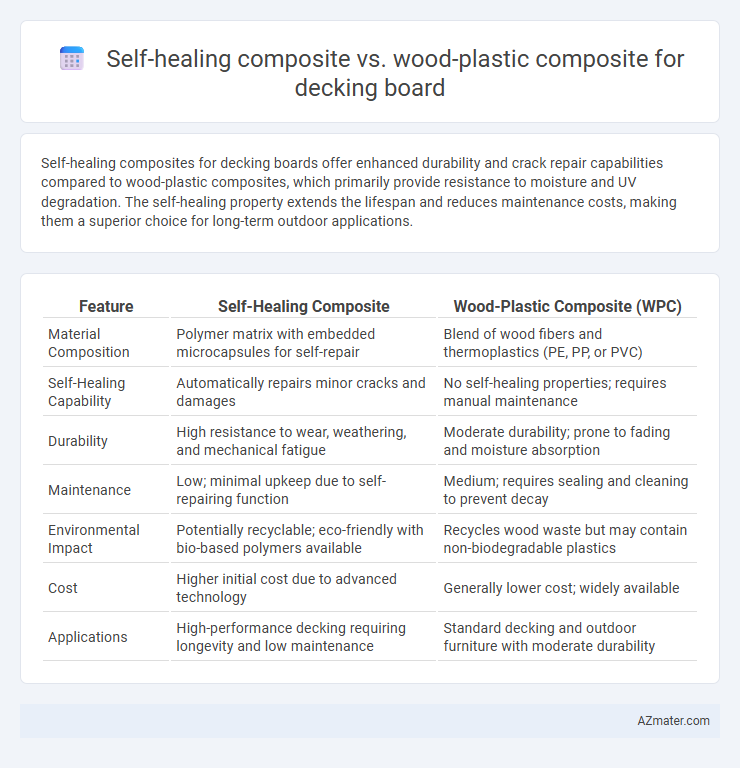Self-healing composites for decking boards offer enhanced durability and crack repair capabilities compared to wood-plastic composites, which primarily provide resistance to moisture and UV degradation. The self-healing property extends the lifespan and reduces maintenance costs, making them a superior choice for long-term outdoor applications.
Table of Comparison
| Feature | Self-Healing Composite | Wood-Plastic Composite (WPC) |
|---|---|---|
| Material Composition | Polymer matrix with embedded microcapsules for self-repair | Blend of wood fibers and thermoplastics (PE, PP, or PVC) |
| Self-Healing Capability | Automatically repairs minor cracks and damages | No self-healing properties; requires manual maintenance |
| Durability | High resistance to wear, weathering, and mechanical fatigue | Moderate durability; prone to fading and moisture absorption |
| Maintenance | Low; minimal upkeep due to self-repairing function | Medium; requires sealing and cleaning to prevent decay |
| Environmental Impact | Potentially recyclable; eco-friendly with bio-based polymers available | Recycles wood waste but may contain non-biodegradable plastics |
| Cost | Higher initial cost due to advanced technology | Generally lower cost; widely available |
| Applications | High-performance decking requiring longevity and low maintenance | Standard decking and outdoor furniture with moderate durability |
Introduction to Decking Board Materials
Self-healing composites represent an advanced category of decking board materials engineered to autonomously repair surface damages, enhancing durability and lifespan compared to traditional wood-plastic composites (WPC). Wood-plastic composites combine wood fibers with thermoplastics to provide a balance of natural aesthetics and resistance to rot and decay, yet they remain susceptible to cracking and deformation over time. Advances in self-healing technology in decking materials significantly improve maintenance efficiency, making them a promising choice for long-term outdoor applications, outperforming standard WPC in resilience and sustainability.
Overview of Self-Healing Composites
Self-healing composites for decking boards integrate microcapsules or vascular networks containing healing agents that autonomously repair micro-cracks, enhancing durability and lifespan compared to traditional wood-plastic composites. These advanced materials improve resistance to environmental stressors, such as moisture and UV exposure, reducing maintenance requirements and extending service life. The incorporation of self-healing mechanisms significantly elevates the structural integrity and sustainability of decking solutions in outdoor applications.
Understanding Wood-Plastic Composites
Wood-plastic composites (WPCs) combine wood fibers and thermoplastics to create durable, low-maintenance decking boards resistant to rot, insects, and moisture. Compared to traditional wood, WPCs exhibit enhanced dimensional stability and require less frequent sealing or staining, making them ideal for long-term outdoor use. While self-healing composites offer advanced crack repair capabilities, WPCs remain widely favored for their balance of cost-effectiveness, environmental sustainability, and ease of fabrication in decking applications.
Durability and Lifespan Comparison
Self-healing composites exhibit superior durability compared to wood-plastic composites due to their ability to autonomously repair micro-cracks and surface damage, significantly extending the decking board's lifespan. Wood-plastic composites, while resistant to rot and insects, tend to degrade over time from UV exposure and mechanical wear, resulting in a shorter functional lifespan. The self-healing mechanism in advanced composites reduces maintenance needs and preserves structural integrity, making them a more long-lasting and resilient choice for outdoor decking applications.
Maintenance Requirements and Ease
Self-healing composites for decking boards significantly reduce maintenance requirements by automatically repairing minor damages like scratches and cracks, enhancing durability and longevity compared to wood-plastic composites (WPC). WPC decking demands regular upkeep such as cleaning, sealing, and occasional sanding to prevent fading, warping, and deterioration from moisture exposure. The ease of maintenance favors self-healing composites, offering homeowners a low-maintenance alternative with superior resistance to wear and environmental factors.
Environmental Impact and Sustainability
Self-healing composites for decking boards offer enhanced environmental benefits by reducing material waste and extending product lifespan through intrinsic repair mechanisms, thus lowering the demand for resource extraction compared to wood-plastic composites (WPCs). Wood-plastic composites, while utilizing recycled plastics and wood fibers, often face challenges related to biodegradability and microplastic pollution during degradation. The self-healing technology not only promotes sustainability by minimizing landfill contributions but also supports circular economy principles more effectively than conventional WPCs.
Cost Analysis: Installation and Long-term Value
Self-healing composites typically have higher initial installation costs compared to wood-plastic composites due to advanced material technology and specialized manufacturing processes. Wood-plastic composites offer lower upfront expenses and simpler installation but may incur higher long-term maintenance costs due to wear and environmental damage. Over time, self-healing composites provide better value through reduced repair frequency, extended lifespan, and sustained aesthetic appeal, offsetting their initial investment with lower total ownership costs.
Aesthetic Options and Customization
Self-healing composites for decking boards offer a broader range of aesthetic options with enhanced color retention and surface texture customization compared to wood-plastic composites (WPC). The advanced polymer matrix in self-healing composites allows for innovative finishes such as wood grain replication and metallic sheens that remain vibrant despite environmental exposure. In contrast, wood-plastic composites provide limited customization, primarily available in wood-like shades with less flexibility in texture variety and color stability.
Performance in Extreme Weather Conditions
Self-healing composites exhibit superior resilience in extreme weather conditions due to their ability to autonomously repair micro-cracks caused by temperature fluctuations, UV exposure, and moisture, significantly extending decking board durability. Wood-plastic composites (WPCs) offer moderate weather resistance but are prone to surface cracking, swelling, and fading over time when exposed to harsh environments. The enhanced performance of self-healing materials reduces maintenance costs and preserves structural integrity, making them a more reliable choice for outdoor decking in variable and severe climates.
Choosing the Right Composite for Your Decking Needs
Self-healing composites offer enhanced durability and longevity by automatically repairing microcracks, making them ideal for high-traffic decking areas exposed to wear and weather. Wood-plastic composites provide a natural wood appearance combined with low maintenance and resistance to rot and insects, suitable for homeowners prioritizing aesthetics and budget-friendly options. Selecting the right decking material depends on balancing performance demands with visual preferences and long-term maintenance considerations.

Infographic: Self-healing composite vs Wood-plastic composite for Decking board
 azmater.com
azmater.com